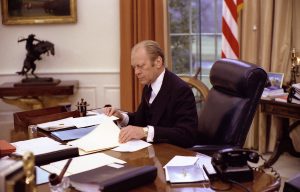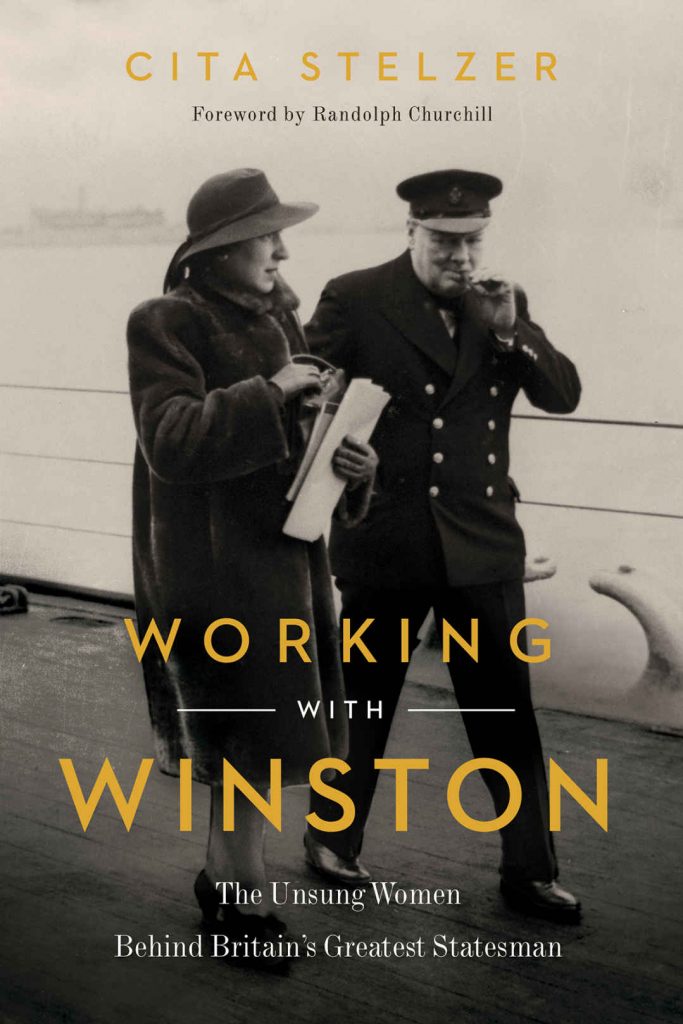
Bulletin #134 – Aug 2019
Front Seats to History

August 5, 2019
Cita Stelzer, Working with Winston: The Unsung Women behind Britain’s Greatest Statesman, Pegasus, 2019, 400 pages, $28.95/£20. ISBN 978–1643130194
Review by KATHERINE CARTER
One room at Chartwell holds a crucial part of the secret of Churchill’s phenomenal political and literary output. Yet few people have had the chance to look inside. Thankfully this is about to change. From spring 2020 the Secretaries’ Office will become part of the visitor route, and for the first time the National Trust will be able to tell the stories of the loyal secretaries who helped the lion roar. Cita Stelzer’s new book Working with Winston, therefore, could not have arrived at a better time. I knew it would be a vital tool in helping to tell the stories of these remarkable individuals, largely women, but also for the mirror that their histories hold up to the everyday life of the man himself, and how they in turn dedicated their lives to Churchill.
The opening of Stelzer’s book immediately stresses their importance, outlining how the term “secretary” must be considered within its contemporary context and how the breadth and complexity of the tasks the “secretaries” managed would warrant a much more senior title today. Stelzer also acknowledges the qualities which were common across all of those who were able to handle both the pace and the pressure of the role: their intelligence, confidence, shrewdness, and perhaps most importantly, their loyalty. It is then that we meet each of them one by one.
Stelzer’s account weaves together personal statements from the individuals themselves, complimented by contemporaries’ recollections and subsequent historiography. By approaching the subject matter in this way, she creates a wonderfully rich picture of each of the protagonists as well as understanding the relationships between them and with the Churchills themselves. The result is a remarkable blend of everyday life for these remarkable people, through to bearing witness to some of the most extraordinary events in twentieth century history. (I should add that I refrain from collectivising the group as women owing to the presence of one gentleman amongst their ranks.)

2025 International Churchill Conference
The story of each individual is told beautifully and offers micro-stories unto themselves. For example, even though there would have been a great deal of commonality to their experience over the years, owing largely to Churchill’s own preference for continuity, themes such as the typical working day, tasks undertaken, working environment, and the particular nuances of working with Winston are all addressed without a sense of repetition or a sense of straining to avoid it. Instead what has been created is a seamless narrative, where despite the difficulties of a shifting chronology resulting from a thematic approach, readers find themselves happy to be guided with ease by Stelzer through the individuals’ lives and experiences.
One thing that surprised me was how effortlessly telling the stories of the lives of Churchill’s secretaries in turn becomes another history of the great man himself—but it does not fall into the trap of letting this dominate the narrative and instead offers something really refreshing. The eyes through which we see Churchill are those who arguably saw him at his most raw, feeling the pressure of circumstances around him, and not feeling in any way as if he had to perform or impress. They arguably saw the worst side of the great man, and yet all stayed with him, knowing that his tempers and frustrations would soon pass, and seeing the bigger picture of how their role could impact on events and, in turn, the course of history.
If I were to lay one minor criticism at Stelzer’s door, it would be that there are instances where key players are not introduced or given any context—something which may be needed for those just dipping their toe in the water of Churchill-history. We at Chartwell are very mindful of this, and as we see new audiences coming through our doors, we work hard to not impose a presumed level of knowledge on them and instead are finding an increased need to introduce these individuals who were once household names. For example, I have no doubt that many readers of Finest Hour will be instantly aware of who is being spoken about when a reference to Beaverbrook is made, but for those newer to the subject, which we will see more of as time passes, perhaps a brief explanatory note would be appreciated. As the subject of Churchill’s life passes from living memory into history, this is something that all of us who share the stories of his life will need to be increasingly mindful of.
This really is a minor niggle, and overall this book is excellent, offering unique insights, a fresh new approach and does so in a way where you quite simply cannot put this book down. One comes away completely in awe of those who worked with Winston, with a hint of jealousy in the mix. These remarkable individuals each had a front-row seat at the making of history itself and witnessed proceedings of national and international importance in one of the most extraordinary periods in our history. It is clear though that through their thick skin, fierce loyalty, and in many cases personal sacrifice, there are few who could have been more worthy of those very seats.
Katherine Carter is Projects Curator and Collections Manager at Chartwell.
Subscribe
WANT MORE?
Get the Churchill Bulletin delivered to your inbox once a month.





